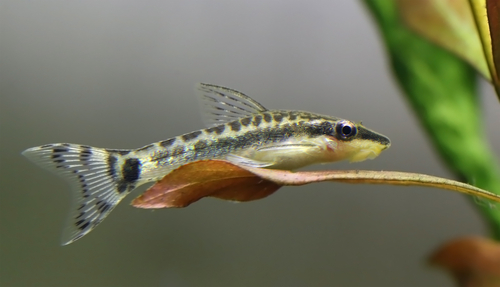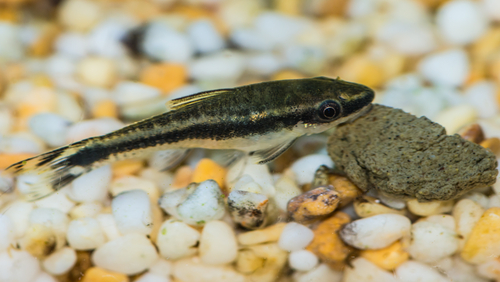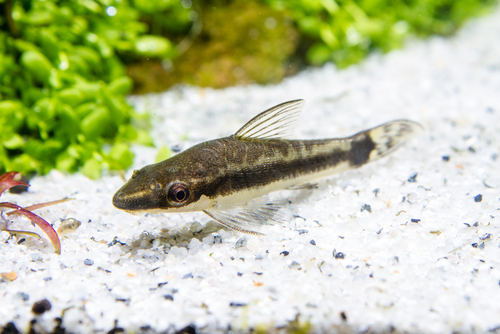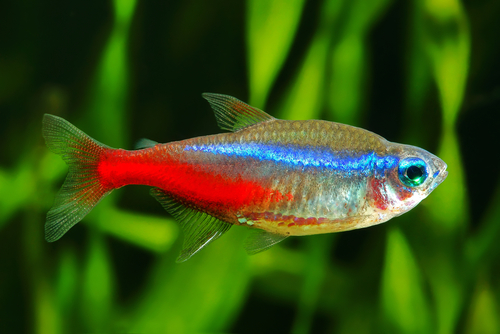Otocinclus is a popular freshwater fish among aquarium enthusiasts. They are known for their small size and peaceful nature, making them an excellent addition to community tanks.
However, feeding otocinclus can be a bit tricky as they have specific dietary requirements. In this article, we will discuss what to feed otocinclus and how to ensure they receive a balanced diet.
Understanding Otocinclus’ natural diet is crucial when it comes to feeding them in captivity. In their natural habitat, otocinclus primarily feed on algae, biofilm, and small invertebrates.
Therefore, it’s essential to replicate their natural diet in the aquarium to ensure they remain healthy and happy. Feeding them a diet that doesn’t meet their nutritional needs can lead to health problems and even death.
Feeding Otocinclus in captivity requires a bit of effort and planning. Apart from algae, biofilm, and small invertebrates, they also need a variety of other foods to stay healthy.
In the next section, we will discuss the different types of food you can feed otocinclus and how to ensure they receive a balanced diet.
Contents
Key Takeaways on What to Feed Otocinclus
- Otocinclus primarily feed on algae, biofilm, and small invertebrates in their natural habitat.
- Feeding otocinclus in captivity requires replicating their natural diet and providing them with a variety of other foods to ensure they receive a balanced diet.
- A balanced diet is essential for the health and well-being of otocinclus in captivity.
Check out these other dietary needs for your aquatic friends:
Understanding Otocinclus

Otocinclus, also known as otocinclus catfish, otos, or algae eaters, are popular freshwater catfish that are often kept as pets in aquariums. These small fish are known for their ability to effectively clean algae from tanks, making them a great addition to any aquarium.
One of the most popular species of otocinclus is the zebra otocinclus, which is known for its black and white striped appearance.
These fish are also sometimes referred to as dwarf suckers due to their small size and their ability to suction onto surfaces.
While otocinclus are primarily known for their algae-eating abilities, it is important to note that they do require a balanced diet in order to thrive. In addition to algae, otocinclus should be fed a variety of other foods, such as sinking pellets and blanched vegetables.
It is also important to note that otocinclus are social creatures and do best when kept in groups of at least three to five individuals.
When selecting tank mates for otocinclus, it is important to choose fish that are peaceful and will not compete with them for food.
Natural Diet of Otocinclus
Otocinclus is a type of catfish that feeds mainly on algae and biofilm. In their natural habitat, they can be found in slow-moving streams and rivers with dense vegetation, where they graze on various types of algae.
One of the most common types of algae that otocinclus feeds on is diatoms.
Diatoms are microscopic algae that are found in freshwater and saltwater environments. They are a major food source for many aquatic organisms, including otocinclus.
Soft green algae and green spot algae are also popular food sources for otocinclus. These types of algae are commonly found in aquariums and can be easily grown on rocks, driftwood, or other surfaces in the tank.
Brown algae, also known as diatomaceous algae, can also be consumed by otocinclus. However, it is not a preferred food source and should only be fed to them if other food sources are unavailable.
In addition to algae, otocinclus also feed on biofilm. Biofilm is a thin layer of microorganisms that forms on surfaces in the aquarium, such as rocks, plants, and substrate.
It is a natural food source for otocinclus and provides essential nutrients for their growth and development.
To ensure that otocinclus receive a balanced and nutritious diet, it is recommended to supplement their natural diet with algae wafers or pellets. Algae wafers are specially formulated to provide the necessary nutrients and vitamins that otocinclus need for optimal health.
When feeding otocinclus, it is important to avoid overfeeding. Overfeeding can lead to digestive problems and other health issues. It is recommended to feed otocinclus small amounts of food several times a day, rather than one large feeding.
Feeding Otocinclus in Captivity

Otocinclus are herbivorous fish that require a varied diet to maintain optimal health in captivity.
They are known to graze on algae and biofilm in their natural habitat, but in an aquarium, they require a more diverse diet to meet their nutritional needs.
One of the most commonly recommended foods for Otocinclus in captivity is algae wafers. These wafers are specifically designed to provide the necessary nutrients for herbivores like Otocinclus. They can be found in most pet stores and are easy to feed.
In addition to algae wafers, Otocinclus can also be fed blanched vegetables such as zucchini, cucumber, and spinach.
These vegetables should be cut into small pieces and boiled or steamed before being fed to the fish. Otocinclus can also be fed lettuce and peas, but these should be fed sparingly as they are not as nutritious as other vegetables.
Shrimp and other small invertebrates can also be included in the Otocinclus’ diet. Brine shrimp and bloodworms are good sources of protein and can be fed occasionally.
However, it is important to note that Otocinclus are primarily herbivores and should not be fed a diet that is too high in protein.
Live plants, such as anubias and kale, can also be included in the Otocinclus’ diet. These plants provide additional nutrition and also serve as a natural source of grazing for the fish.
Pellets and Repashy can also be fed to Otocinclus, but it is important to ensure that these foods are specifically formulated for herbivores.
Food to Avoid Feeding Otocinclus Catfish
When deciding what to feed otocinclus catfish, certain foods should be avoided in their diet. These foods are eggs, meat, fish and Insects.
These items are not part of their natural diet and can lead to health issues such as bloating and digestion problems.
Feeding Guidelines
When feeding otocinclus catfish, establishing a feeding routine is vital for the well-being of your Otos. This practice ensures they receive appropriate nutrition and guards against excessive feeding.
It is advisable to:
- Feed them once or twice daily.
- Dispense a modest food portion during each feeding.
- Offer an amount that can be consumed within 2-3 minutes.
- Promptly get rid of any uneaten food from the tank.
Otocinclus Tank Environment
Creating a suitable tank environment for otocinclus is essential for their well-being. Otocinclus are sensitive fish that require specific water parameters and tank conditions to thrive.
When setting up an aquarium for otocinclus, it’s important to consider the water quality. Otocinclus prefer soft, slightly acidic water with a pH range of 6.5-7.5.
They also require a well-cycled tank with low levels of ammonia and nitrite. Regular water changes of 10-20% every week can help maintain optimal water quality.
In addition to water quality, the tank environment should also include suitable decorations and live plants. Otocinclus prefer a natural environment with plenty of hiding places.
Driftwood, rocks, and live plants such as cabomba and cryptocorynes can provide hiding places and help create a natural environment.
Lighting is also an important factor to consider. Otocinclus prefer low to moderate lighting levels, as high levels of light can encourage algae growth, including hair algae.
Slow-growing plants such as echinodorus and java moss can help control algae growth and provide a natural food source for otocinclus.
When choosing a tank size for otocinclus, a minimum of 10 gallons is recommended for a small group of 3-5 fish.
A filter should also be included in the tank setup to maintain water quality and provide adequate water flow.
Filtration
In terms of filtration, Otocinclus Catfish aren’t overly particular. If your tank’s filtration system cannot maintain water quality at an optimal level, it can lead to health problems for your fish. This may result in internal or external infections, diseases, or even fatalities.
A high-quality aquarium filter serves their need for ample dissolved oxygen and helps maintain clean, well-oxygenated water.
To prevent your fish from becoming stressed, it’s wise to minimize water agitation. Otocinclus Catfish prefer a moderate to high water flow, which can be achieved through an aquarium filter.
Consider these filter recommendations for Otocinclus Catfish:
- Tetra Whisper In-Tank Filter: A solid choice for smaller tanks, accommodating aquariums up to 10 gallons.
- AquaClear 50-70: These filters are suitable for tanks up to 70 gallons, delivering effective water circulation and filtration.
- Fluval 205 Canister Filter: For larger tanks, these filters can handle up to 100 gallons.
Otocinclus Species and Origin

Otocinclus is a genus of small catfish that belong to the family Loricariidae. They are commonly known as otocinclus catfish or dwarf suckers.
These fish are native to South America, particularly Venezuela, Argentina, and other countries in the region.
There are several species of otocinclus catfish, including Otocinclus vittatus, Otocinclus cocama, and Otocinclus macrospilus. Each species has its unique characteristics, but they all share a similar appearance and behavior.
Otocinclus vittatus, also known as the striped otocinclus, is the most common species found in the aquarium trade. They are peaceful and easy to care for, making them a popular choice for beginner aquarists.
Otocinclus cocama, also called the zebra otocinclus, is a bit larger than other species and has a distinctive black and white striped pattern. They are also peaceful and do well in community tanks.
Otocinclus macrospilus, or the oto catfish, is a bit more challenging to care for and is less commonly found in the aquarium trade. They are slightly larger than other species and have a more elongated body shape.
Understanding Otocinclus Behavior
Otocinclus are small, peaceful fish that are commonly kept in aquariums. They are bottom feeders and spend most of their time grazing on algae and other debris on the substrate and aquarium decorations.
Understanding the behavior of otocinclus can help you provide them with the right environment and diet to keep them healthy and happy.
1. Active Behavior
Otocinclus are active during the day and night, but they tend to be more active at night. They are also more active when they are hungry, so it’s a good idea to feed them small amounts of food several times a day rather than one large meal.
2. Size

Otocinclus are small fish, typically growing to a maximum length of around 2 inches. Because of their small size, they are vulnerable to stress and can be easily injured by larger fish or aggressive tank mates.
It’s important to keep them in a peaceful aquarium with other small, peaceful fish.
3. Peaceful Fish
Otocinclus are peaceful fish that do well in community aquariums. They are social animals and should be kept in groups of at least three to five fish. They are also compatible with other peaceful fish such as tetras, guppies, and corydoras.
4. Bottom Feeders
Otocinclus are bottom feeders and prefer to graze on algae and other debris on the substrate and aquarium decorations.
They also enjoy small amounts of vegetable matter such as blanched spinach or zucchini. It’s important to provide them with a varied diet to ensure they get all the nutrients they need.
5. Night Behavior
Otocinclus are more active at night and may be seen swimming around the aquarium during the dark hours. They are also more likely to feed at night, so it’s a good idea to provide them with food before turning off the aquarium lights.
6. Stress
Otocinclus are sensitive to stress and can be easily injured or killed by sudden changes in water chemistry or temperature.
It’s important to keep their aquarium clean and well-maintained, and to avoid overcrowding or adding aggressive tank mates.
7. Lifespan

Given favorable conditions, Otocinclus Catfish typically live for a span of 3 to 7 years. However, an otocinclus diet and water parameters that are unfavorable, can shorten their lifespan. Inadequate nutrition and poor water quality can all contribute to a decreased life expectancy for the otos.
How Many Otocinclus in 5 Gallon Tank?
When thinking about how many Otocinclus to have in your 5-gallon tank, remember these little fishes are tiny and can overcrowd easily. It’s a good idea to limit the stock to just two or three of them, as they need space to swim around and hide comfortably. By arranging the right mix of substrate, plants, and tank decorations, your 5-gallon aquarium can turn into a great home for your small Otocinclus group.
A handy guideline to remember is that for every inch of fish, you should provide at least one gallon of swimming room. Given that mature Otos are typically around two inches in length, each of them will need approximately two gallons of space to thrive in your tank.
Choosing Tank Mates for Otocinclus

When it comes to choosing tank mates for Otocinclus, it is important to consider their peaceful nature and small size. Otocinclus are best kept with other peaceful fish that won’t harass or outcompete them for food.
It is recommended to avoid keeping Otocinclus with aggressive or territorial fish, as they may become stressed or even injured. Additionally, it is important to ensure that the tank mates are not too large, as Otocinclus can easily become prey for larger fish.
Some suitable tank mates for Otocinclus include other peaceful freshwater fish such as neon tetras, guppies, and corydoras. These fish are similar in size and temperament to Otocinclus, making them great companions.
It is also important to consider the dietary needs of the tank mates. Otocinclus are primarily herbivores and require a diet rich in algae and other plant matter.
Therefore, it is recommended to choose tank mates that have similar dietary requirements.
Buying Otocinclus from Pet Stores
When looking to buy Otocinclus from a pet store, it is important to take a few factors into consideration.
Otocinclus are a popular choice for aquarium enthusiasts due to their low-maintenance nature and ability to keep tanks clean. However, not all pet stores offer high-quality Otocinclus, and it is important to ensure that the fish are healthy before purchasing them.
Firstly, it is recommended to research the pet store before making a purchase.
Look for reviews online or ask other aquarium enthusiasts for recommendations. A good pet store will have a clean and well-maintained environment, with healthy and active fish.
When inspecting the Otocinclus, look for signs of good health such as clear eyes, smooth skin, and active swimming behavior. Avoid purchasing fish that appear lethargic or have any visible signs of illness such as spots or discoloration.
It is also important to consider the tank conditions in which the Otocinclus are kept at the pet store. Otocinclus require a well-maintained tank with good water quality and a suitable diet.
Ask the pet store staff about the tank conditions and diet of the Otocinclus to ensure that they are being properly cared for.
Conclusion
The best food for otocinclus is soft green algae. However when Otocinclus catfish get hungry, they may resort to eating fish flakes or search for any available food if their preferred options are not provided.
Otocinclus catfish are typically hardy but can fall prey to parasites and fungi. To ensure their well-being, maintain a clean tank and watch for signs of illness like changes in color, unusual spots, or decreased activity.
These little Otocinclus make charming additions to your tank, and with proper care and affection, they can enjoy a long and healthy life.
Frequently Asked Questions
What are the best algae wafers for Otocinclus?
Otocinclus are herbivorous fish that require a balanced diet of algae and other plant matter.
There are several brands of algae wafers that are suitable for Otocinclus, including Hikari Algae Wafers, Omega One Veggie Rounds, and Tetra Algae Wafers. It is important to choose a high-quality brand that is specifically formulated for herbivorous fish.
How many Otocinclus can I keep in a 5-gallon tank?
It is not recommended to keep Otocinclus in a tank smaller than 10 gallons. In a 5-gallon tank, you should only keep one or two Otocinclus, as they require ample swimming space and water volume to thrive.
What is the diet of Zebra Otocinclus?
Zebra Otocinclus have a similar diet to other Otocinclus species and require a balanced diet of algae and other plant matter. In addition to algae wafers, they can also be fed blanched vegetables such as zucchini and cucumber.
What are the ideal water parameters for Otocinclus?
Otocinclus are sensitive to poor water quality and require clean, well-oxygenated water. The ideal water parameters for Otocinclus are a pH between 6.5 and 7.5, a temperature between 72°F and 78°F, and a water hardness between 2 and 12 dGH.
What are some suitable tank mates for Otocinclus?
Otocinclus are peaceful fish that can be kept with a variety of other small, non-aggressive species. Some suitable tank mates for Otocinclus include small tetras, rasboras, and guppies.
How do I prepare zucchini for Otocinclus?
To prepare zucchini for Otocinclus, slice it into thin rounds and blanch it in boiling water for a few minutes. Allow the zucchini to cool before adding it to the tank.
Alternatively, you can attach a slice of zucchini to a vegetable clip and place it in the tank for the Otocinclus to graze on.

Ian Sterling, founder of Fishlab.com, began his aquarium journey over 30 years ago, driven by a deep fascination for fish and their diverse personalities. His website, Fishlab.com, is dedicated to making fishkeeping accessible and enjoyable, offering beginner-friendly guidance, expert insights, and a community for aquarists to connect and share experiences.


